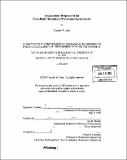Temperature response of the ultra-high throughput mutational spectrometer
Author(s)
Suen, Timothy W. (Timothy Wu)
DownloadFull printable version (2.505Mb)
Other Contributors
Massachusetts Institute of Technology. Dept. of Mechanical Engineering.
Advisor
Ian W. Hunter.
Terms of use
Metadata
Show full item recordAbstract
The Ultra-High Throughput Mutational Spectrometer is an instrument designed to separate mutant from wild type DNA through capillary electrophoresis. Since this technique uses the melting point of the molecule to distinguish between sequences of base pairs, temperature control is crucial to the success of the device. The purpose of this analysis is to characterize the temperature response of the instrument, taking into account the heat dissipated by the 10,000 capillaries in the system during electrophoresis. Analytical models, finite element analysis, and physical models were used to predict the steady state response of the system to heat generated by capillary electrophoresis. The analytical models estimated a steady state offset of 0.2 K for water at 3.3x 10Ì„⁴ m³/s (20 L/min) and 1.0 K for water at 6.7x 10Ì„⁵ m³/s (4.0 L/min) and predicted that the system would reach steady state within several seconds. Finite element analysis determined that the gel inside the capillaries would have a steady state offset of 0.24 K. The physical system, which simulated the Joule heating of the capillaries using an immersion heater, yielded a steady state offset of 0.24 K at 3.3x 10Ì„⁴ m³/s and 0.65 K at 6.7x 10Ì„⁵ m³/s, but the settling time in both cases was on the order of 500 s. (cont.) This discrepancy is due to the fact that many aspects of the physical system, including the thermal mass of the instrument, heat loss through convection, and the PID temperature controller in the circulator, were not taken into consideration in the theoretical analysis. Pressure drop and vortex shedding were also calculated for the instrument. Finite element analysis determined the pressure drop to be 18.55 Pa. Vortex shedding does not occur, because the operating conditions of this instrument are below the critical Reynolds number.
Description
Thesis (S.B.)--Massachusetts Institute of Technology, Dept. of Mechanical Engineering, 2005. Includes bibliographical references (p. 43-44).
Date issued
2005Department
Massachusetts Institute of Technology. Department of Mechanical EngineeringPublisher
Massachusetts Institute of Technology
Keywords
Mechanical Engineering.